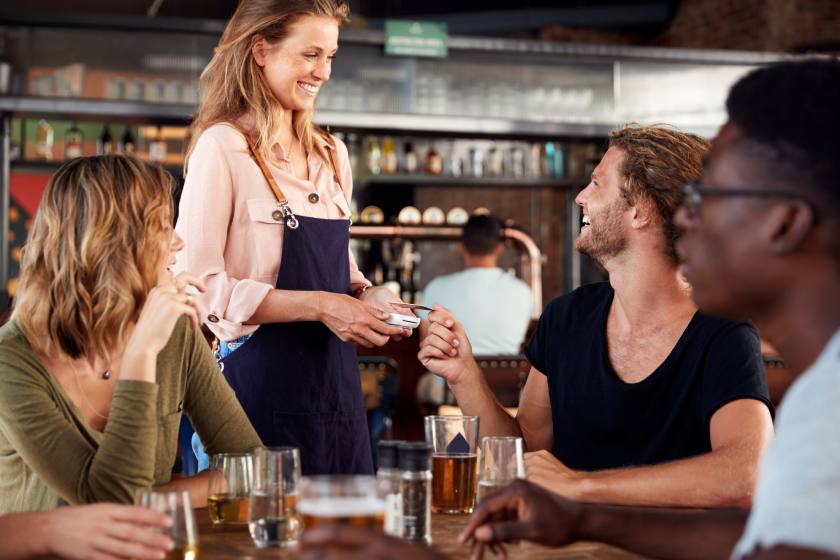
A bar tab is a running list of a customer’s orders, organized by name or number so it is easy to track. Bar tabs serve several functions, from keeping orders organized to ensuring customers only have one drink at a time (which is important when serving alcohol to the general public). Knowing how a bar tab works and its benefits can make a huge difference in bar operations. I cover these more in-depth below.
How Do Bar Tabs Work?
A bar tab is a running account of all the food and drinks a customer orders at a bar. Bar tabs are necessary because bar patrons are typically not tied to a table. They allow bartenders to efficiently and quickly serve customers without cashing out after every order. Typically, the bar tab will be identified by the customer’s name. This improves the speed of service and enables bartenders to track how much they serve each customer with accuracy.
How to Use Bar Tabs
Bar tabs do a lot of work; they track orders, process payments, and log how much each customer is served. It is virtually impossible to run bar tabs without a point-of-sale (POS) system—bars are too busy and bartenders have too many tasks to keep track of orders manually. So, if you don’t yet have a POS for your bar, make that your first priority.
It is important to know if your POS system allows pre-authorization. This lets the system pre-authorize the card for a small amount (ensuring the card is valid) and stores the payment information on the tab (so your bartenders don’t need to hold onto customer credit cards).
Most modern POS systems offer pre-authorization. Check out our rankings of bar POS systems and restaurant POS systems.
Here’s a step-by-step breakdown of how to use bar tabs:
Step 1: Open Tab
A bar tab can be started by a bartender behind the bar or a cocktail server from the bar floor. When a customer places an order at the bar or with a server, your staff should ask if the customer would like to start a tab.
The bartender or server then requests a form of payment—generally a credit or debit card—to secure the tab. No payment is collected at this point.
Step 2: Secure Tab
There are two main ways to secure a bar tab: hold onto the customer’s card or use pre-authorization through a POS system.
The first option involves keeping the customer’s card and then starting a check labeled with the customer’s last name, the last four digits of the card, or a combination of both so the tab and card can be easily paired when it’s time to close the tab. Many bars use an alphabetized index card file box to store cards by customer name to speed closeouts. Others hold cards in the bar’s cash drawer.
This is less than ideal as it can make a ready target for would-be thieves (both on your staff or in your bar). But it’s preferable to the alternative of having your staff hold cards individually, as a central holding place makes it easy for anyone to close a tab when a customer is ready.
The best way to secure a bar tab is the second option: using a POS system that pre-authorizes cards. With POS pre-auth, the card information is saved and attached to the customer check in the POS. The card number is vaulted, so no one can see it, but the card information is in the system when you need to close the tab.
With most POS systems this process is as simple as swiping the card through the POS system. The card swipe will generally open the tab and assign the customer’s name to it.
Step 3: Add Customer Orders to the Tab
A customer will place orders for drinks or food throughout the night by communicating with the bartender or server, who will then, in turn, add the orders to the tab and serve them drinks. The bartender is responsible for ensuring the customer’s order is accredited to the correct tab open on the POS system. The POS system uses the credit card on file and the ordering system within the POS to track the tab and tally up the total owed.
Step 4: Review & Close Tab
When the customer is ready to leave, they may want to check their tab. The bartender should be able to print out a current tab for the customer, reviewing what they ordered and the expected total of their bar tab. Once this is done, the customer can ask the bartender to close the tab with the payment type on file or choose to use a different payment type (like cash).
Step 5: Process Payment & Finalize Tab
The bartender or server will process the customer’s preferred form of payment for the bar tab. If the customer has chosen to pay in cash, the items in the POS system are voided, and the cash payment is accredited to the bar tab in the system.
If the customer chooses to pay for the tab with the card used to create the tab, the POS system simply processes this payment. At this point, the customer can choose to tip the bartender, and then the tab is closed, payment is accepted, and the transaction is finalized.
Ideally, the customer is still present to sign a paper or digital copy of the credit card slip. If the customer has left without closing their tab—which happens at least once a night in most places—your staff can close the tab using the payment on file. The ability to close all your tabs at the end of a busy night is one of the major benefits of using bar tabs.
Benefits of Using a Bar Tab
A restaurant or bar will mainly use a bar tab to drive efficiency, but it also has various other benefits:
- Efficiency: Bar tabs allow your staff to take and prepare orders without constantly stopping the flow of service to have customers pay for their drinks. Instead, the bartender is freed up to make drinks, be more attentive to guests, and focus on the task at hand.
- Easier order tracking: It is important to know how much has been served to an individual guest as well as what they have ordered before. Having a bar tab makes tracking an individual customer’s order much easier.
- Higher sales potential: When a customer opens a tab, they are often more likely to order more drinks and stay longer at the restaurant or bar. With the friction of ordering reduced, the customer is likely to order more.
- Easier group billing: Tabs are also a great way to organize orders for a group of people, simplifying large group orders for the bartender. Additionally, since every patron can open their own tab, there is no reason to split checks when customers are ready to close out.
- Speedier transaction: Due to the batching of orders on a bar tab, the customer can try multiple items off of your menu and still pay with the speed at which they would if they ordered just one drink. Furthermore, the card on file can often just be run automatically, making payment a much smoother process.
Best Practices for Managing Bar Tabs
Having the ability to open bar tabs is a major win for a bar or restaurant. That being said, there are specific, proper procedures you will need to follow to ensure that the tab being opened is secure and managed correctly. Use these best practices below to manage bar tabs in a responsible, efficient, and customer-friendly way.
- Pre-authorize payment: Use a POS system that supports credit card pre-authorization. Pre-auths reduce the risk of holding customer cards and ensure that you can process payment if the customer forgets to close their tab.
- Have a secure opening procedure: Opening a bar tab will consist of running a customer’s credit card. When opening a tab, a credit card should always be on file for the customer to order. Furthermore, ID must be checked and verified for all guests on a tab before it is ever opened.
- Keep the customer informed: Explain to your customers how the bar tab works, including how to open the tab, pay for the tab, and close out the tab when they are done. This reduces customer confusion, which is always a good idea when alcohol is involved. Many bars print their bar tab procedure and post it somewhere in the bar so customers can refer to it at any time.
- Understand your POS tracking: For POS systems, you can often name a specific customer’s tab to track it. Understanding how your POS tracks bar tabs and how you can identify individual ones throughout service is paramount to utilizing the bar tab tools of your POS system.
- Consider limits: Checking in on open bar tabs is key to maintaining accurate and in-depth orders. Setting limits to the amount of drinks a customer can order is an option, especially when considering customer safety. Checking in and setting limits is a great way to manage the liability of serving alcohol.
- Verify orders before closing: Train your bartenders to verify orders with customers when closing a bar tab to avoid discrepancies. This is always best practice, as ordering is done over a longer period of time. A prompt review of the order is always ideal.
- Card security: Do not hold customer cards behind your bar. This can be a target for thieves and can potentially lead to credit card fraud. Holding cards also forces you to deal with cards that customers leave behind. Do you want the responsibility of destroying customer cards or holding them until a customer can come to collect them? A POS system that pre-auths will let you avoid these potential problems.
- Conduct regular audits: Bar management needs to audit tabs throughout a shift to check for any discrepancies and ensure that staff are following proper procedures.
Frequently Asked Questions (FAQs)
Below are some of the most commonly asked questions when it comes to bar tabs.
A bar tab works by pre-authorizing or holding onto a payment when a customer orders drinks at the bar. Then, a running tab of the customer’s order is tracked. Once the customer is done ordering, the card on file or other payment method is accepted. The purpose of the tab is to ensure that the customer can order easily but that they pay for their items at the end of the night.
Bars use bar tabs to reduce liabilities and walk-out checks and speed bar service. By keeping a running tab of drinks ordered at the bar, there is no need to stop and accept payment every time an order is placed. This is efficient for the staff and eliminates a point of friction for the guests. It makes ordering at the bar easy, seamless, and secure.
Bottom Line
Running bar tabs is an excellent way to make ordering easy for customers. Bar tabs also enable your staff to focus on making drinks and serving customers rather than making changes throughout a shift. Pre-authorized bar tabs store customer payment information, so you can ensure that the final bill will be paid before the customer leaves.
With the bar tab at your disposal, you can offer high-quality bar service backed by a secure payment processing method. Use the tips above to build out your bar tab process.





